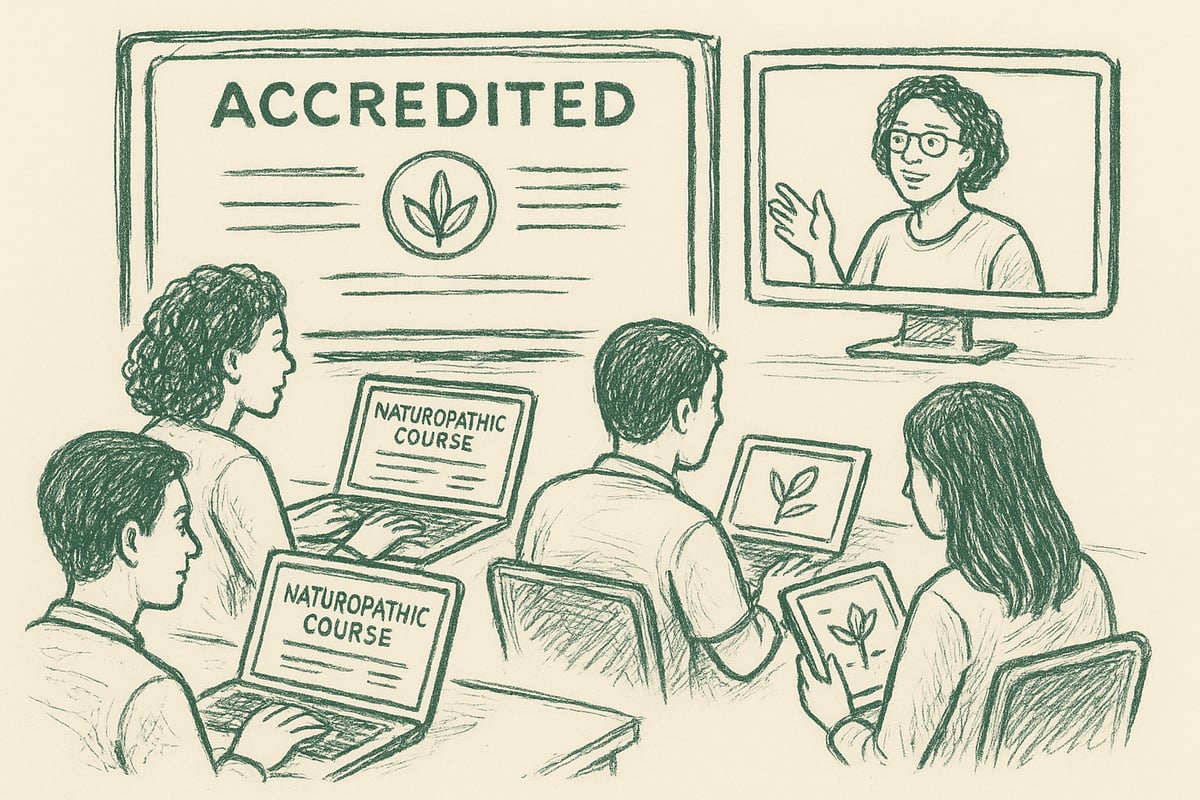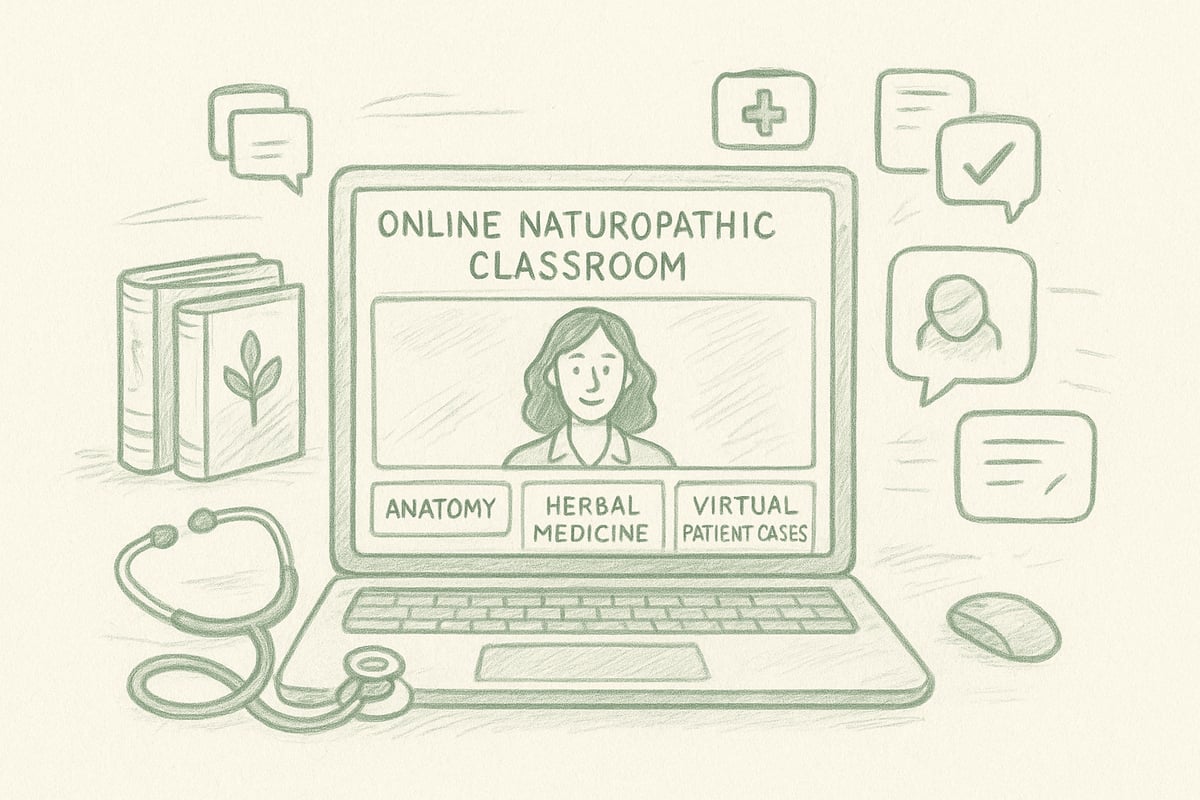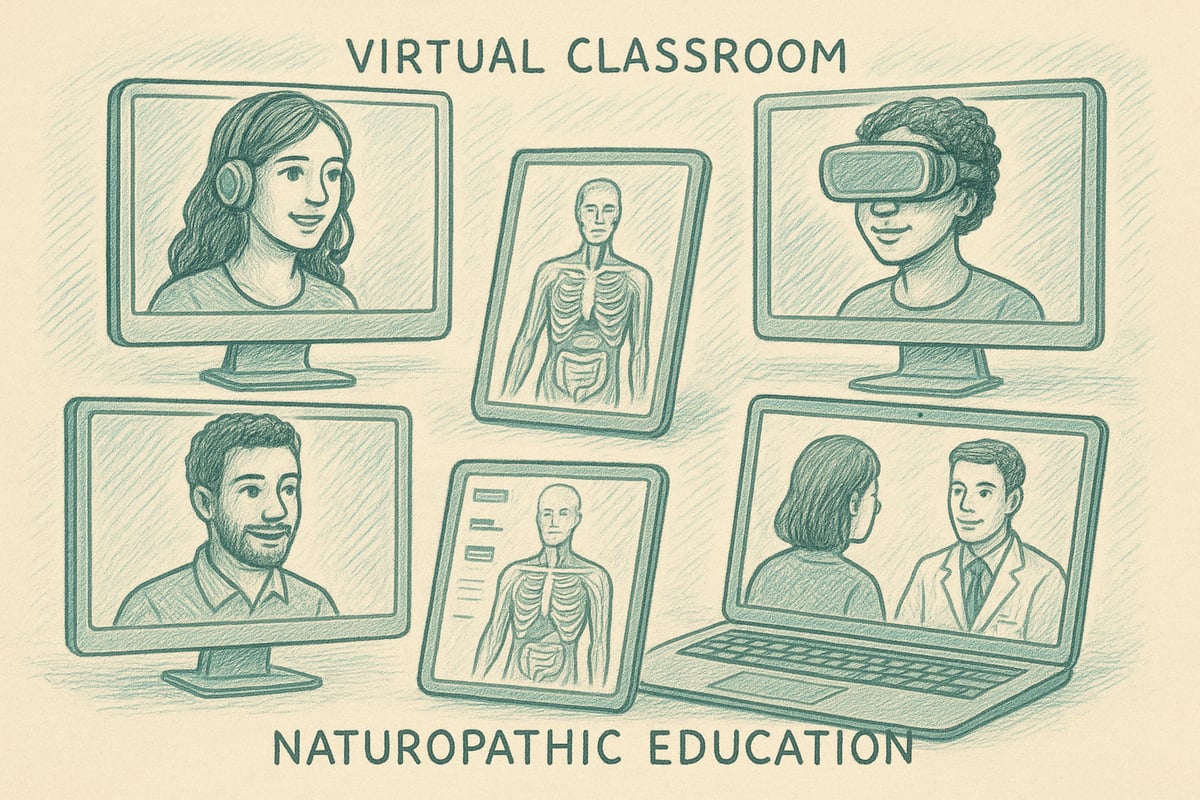Discover how naturopathic education online is transforming holistic healthcare for the next generation. As demand increases for accessible, flexible, and accredited learning, more students are turning to innovative digital programs to pursue careers in evidence-based holistic health, telemedicine, and integrative wellness.
Online learning offers unmatched flexibility, a global classroom, and a curriculum shaped by the latest in health science. This essential 2025 guide will help you explore every aspect of the field, from program types and accreditation to career outcomes and choosing your best path.
Whether you are an aspiring practitioner or a lifelong learner, this resource will give you the tools and insights needed to thrive in the evolving world of naturopathic education online.
The Evolution of Naturopathic Education Online
Naturopathic education online has transformed the landscape of holistic health learning. The digital era is opening new doors for students worldwide, making naturopathic training more accessible and adaptable than ever. As the demand for skilled holistic practitioners grows, this evolution is reshaping how future professionals prepare for integrative health careers.

The Shift to Digital Learning in Holistic Health
The shift from traditional in-person schools to naturopathic education online accelerated rapidly due to the COVID-19 pandemic. Institutions like the National University of Natural Medicine and Bastyr University began offering comprehensive online programs, adapting quickly to student needs.
The online health education market is projected to reach $45 billion by 2025, highlighting the magnitude of this transformation. Student demographics are also evolving, with increased diversity, international enrollment, and more non-traditional learners seeking flexible pathways.
By embracing digital delivery, naturopathic education online is now accessible to a broader audience, breaking down barriers that once limited entry into holistic health professions.
Key Drivers Behind Online Naturopathic Education
Several factors fuel the rise of naturopathic education online. Flexible learning formats attract working adults and career changers who need to balance studies with life commitments. Advances in technology, such as virtual labs and telehealth simulations, support interactive and practical learning experiences.
Affordable, scalable education models address practitioner shortages worldwide. Programs now integrate interdisciplinary content—nutrition, herbal medicine, and mind-body therapies—giving students a comprehensive foundation. Features like asynchronous modules, live clinical webinars, and peer collaboration further enhance the learning journey.
These drivers ensure naturopathic education online meets the evolving needs of today's students and tomorrow's practitioners.
Challenges and Criticisms of Online Naturopathic Education
Despite its growth, naturopathic education online faces unique challenges. Developing hands-on clinical skills in a virtual environment remains a top concern for both students and educators. Program quality and rigor can vary widely, making it crucial to select a reputable, accredited institution. Regulatory hurdles, such as state or provincial licensing and scope of practice, add complexity.
Another issue is the risk of misinformation or pseudoscience in online content. Graduate feedback often reflects mixed experiences regarding the effectiveness of online versus in-person clinical training. To address these concerns, prospective students should prioritize programs that meet established CNME Accreditation Standards for quality and recognition.
Global Reach and Equity in Access
Naturopathic education online is expanding opportunities for students in rural, remote, and underserved areas. By eliminating geographic barriers, these programs make holistic health training accessible to a global audience. Many institutions now offer scholarships, sliding scale tuition, and open-access courses to further improve equity.
A notable case is the growth of online naturopathic programs in Africa, Asia, and Latin America. According to Coursera, there has been a 40% increase in holistic health enrollments from underserved regions since 2024.
This global reach is helping to diversify the field and bring holistic care to communities that need it most.
The Future: Trends Shaping Naturopathic Education
Looking ahead, naturopathic education online is set to benefit from several transformative trends. Micro-credentialing, stackable certificates, and continuing education pathways offer lifelong learning options. AI-driven personalized learning and adaptive assessments tailor education to individual needs.
Community-driven cohorts and mentorship networks foster collaboration and professional growth. Strategic partnerships between universities, clinics, and digital health companies are enhancing clinical training through telehealth practicums and remote patient monitoring.
These trends ensure that naturopathic education online remains at the forefront of innovation, preparing practitioners for the evolving landscape of holistic health.
Accreditation, Standards, and Choosing a Quality Program
Accreditation is the foundation of trust and recognition for anyone considering naturopathic education online. With the surge in remote learning, understanding what defines a quality program has never been more essential. This section breaks down how to identify respected programs, what standards matter, and how to make the right choice for your career.

Understanding Accreditation in Naturopathic Education
When researching naturopathic education online, accreditation should be your top priority. Accredited programs follow rigorous standards for curriculum, faculty, and clinical training, ensuring graduates meet professional requirements. Key accrediting bodies include the Council on Naturopathic Medical Education (CNME) and regional accreditors.
Accreditation directly impacts your eligibility for licensure and professional recognition. For example, most licensing boards only accept degrees from accredited institutions. As of 2025, several respected universities offer CNME-accredited online programs. To understand what defines a quality program, review the Naturopathic Education Accreditation Standards to see the benchmarks your program should meet.
International students and those seeking flexible options benefit from these standards, as they help ensure the value of your naturopathic education online is recognized worldwide.
Evaluating Program Quality and Curriculum Standards
A high-quality naturopathic education online program features a robust curriculum. Look for core courses in biomedical sciences, clinical skills, and holistic health modalities. Clinical training is essential, with minimum hour requirements and supervised patient care.
Faculty credentials matter. Programs should employ board-certified naturopathic doctors, MDs, PhDs, and experienced practitioners. Compare curriculum hours and clinical components across schools to assess depth and breadth:
| Program | Biomedical Sciences (hrs) | Clinical Training (hrs) | Holistic Modalities (hrs) |
|---|---|---|---|
| Example University A | 700 | 1,200 | 400 |
| Example University B | 650 | 1,000 | 450 |
Review these elements closely to ensure your naturopathic education online prepares you for real-world practice.
Red Flags and How to Avoid Diploma Mills
Not all naturopathic education online programs are created equal. Watch for warning signs that may signal a diploma mill:
- Lack of recognized accreditation
- Unrealistically short program durations
- Absence of clinical training or supervised practice
- Vague or missing faculty qualifications
Graduating from unaccredited programs can limit career options and even lead to legal risks. Always read alumni and employer reviews to gauge program reputation. Regulatory actions have been taken against non-compliant online schools, so do your due diligence before enrolling.
Financial Considerations and ROI
Cost varies widely for naturopathic education online. Tuition for certificate, diploma, or doctorate programs ranges from $15,000 to $45,000. Many schools offer financial aid, scholarships, and payment plans to increase access.
To evaluate return on investment, consider career prospects, average salaries, and job placement rates. For example, the median salary for naturopathic doctors is $75,000 (BLS 2024), and accredited programs typically have higher job placement rates.
- Tuition: $15,000–$45,000
- Median ND Salary: $75,000
- Financial aid: scholarships, grants, payment plans
Carefully weigh these factors when selecting your ideal program.
How to Choose the Right Program for Your Goals
Choosing the best naturopathic education online program requires aligning your needs with program strengths. Consider these steps:
- Match program format (asynchronous, synchronous, hybrid) to your learning style.
- Explore specialization tracks like pediatrics, women’s health, or integrative oncology.
- Investigate mentorship opportunities and alumni networks for long-term support.
Use this checklist to vet programs:
- Accreditation status
- Curriculum and clinical training details
- Faculty qualifications
- Student support services
- Reputation and graduate outcomes
By following these criteria, you can confidently select a naturopathic education online pathway that meets your personal and professional goals.
Inside the Online Naturopathic Curriculum: What to Expect
Stepping into the world of naturopathic education online means engaging with a curriculum designed to build both scientific foundations and holistic understanding. Programs are structured to ensure aspiring practitioners gain the knowledge, skills, and confidence needed to thrive in a rapidly evolving health landscape.

Core Subjects and Coursework
At the heart of naturopathic education online is a robust foundation in biomedical sciences and holistic healing principles. Students encounter a blend of classical and contemporary subjects, all presented through interactive online modules.
| Core Subject | Example Topics |
|---|---|
| Anatomy & Physiology | Organ systems, cellular biology |
| Biochemistry | Metabolic pathways, nutrition |
| Pathology | Disease mechanisms, diagnostics |
| Naturopathic Philosophy | Therapeutic Order, healing principles |
| Modalities | Nutrition, botanicals, homeopathy |
A typical first-year course sequence might include:
- Human Anatomy & Physiology
- Foundations of Naturopathic Medicine
- Nutrition & Dietary Therapy
- Botanical Medicine I
- Introduction to Counseling Skills
Naturopathic education online ensures students can access these courses from anywhere, making it easier to balance study with other commitments.
Clinical Training and Virtual Practicum
Hands-on clinical experience is central to naturopathic education online, even when delivered remotely. Programs use a combination of telehealth simulations, standardized patient cases, and virtual labs to develop real-world skills.
Common elements of online clinical training:
- Live telehealth consultations supervised by licensed practitioners
- Interactive simulation labs for diagnostic reasoning
- Case-based learning with virtual patient platforms
- Partnerships allowing local in-person clinical hours
This hybrid approach helps bridge the gap between theory and practice, giving students confidence to apply what they learn in diverse settings.
Integrative and Interdisciplinary Learning
Naturopathic education online increasingly incorporates integrative and interdisciplinary content. Students learn to collaborate with professionals from various fields, broadening their perspective and enhancing patient care.
Key aspects include:
- Functional medicine and mind-body approaches
- Team-based care simulations with MDs, acupuncturists, and chiropractors
- Interprofessional education modules on collaborative practice
- Online integrative case conferences
By engaging with a wide range of modalities and expertise, students become better equipped to meet the needs of modern healthcare environments.
Assessment, Exams, and Certification
Assessment in naturopathic education online is rigorous and multifaceted. Students complete proctored online exams, objective structured clinical examinations (OSCEs), and competency-based assessments tailored to remote learning.
Graduation requirements often include:
- Documented clinical hours
- Capstone research or case projects
- Preparation for board exams such as the Naturopathic Physicians Licensing Examinations Overview
Many programs also issue digital badges or micro-credentials for specialty skills, reflecting the commitment to ongoing professional development.
Student Support, Mentorship, and Community
Success in naturopathic education online is supported by a vibrant network of resources. Virtual office hours, peer study groups, and academic advising are standard features.
Support structures include:
- Discussion forums for collaborative learning
- Career counseling and wellness resources
- Alumni platforms for networking and mentorship
- Live online events to foster community
These tools empower students to build professional relationships, overcome challenges, and stay engaged throughout their educational journey.
Technology and Tools Powering Online Naturopathic Education
Modern naturopathic education online leverages an array of digital tools and platforms to create immersive, flexible, and interactive learning experiences. These technologies not only support foundational coursework but also enable clinical training, collaboration, and compliance, ensuring students are well prepared for holistic healthcare careers.

Learning Management Systems and Course Delivery
The foundation of naturopathic education online is the learning management system (LMS). Top programs use platforms like Canvas, Moodle, or Blackboard, each offering robust features tailored for holistic health curricula.
Key LMS features include:
- Interactive video lectures and quizzes
- Mobile access for learning on the go
- Progress tracking and grade analytics
- Integrated discussion boards and peer feedback
A typical online naturopathic course sequence is organized into modules, enabling students to review concepts at their own pace. Many LMS platforms support both live and recorded sessions, accommodating different learning styles and global time zones. These systems ensure that naturopathic education online remains accessible and organized for diverse learners.
Virtual Labs, Simulations, and Clinical Tools
One of the most innovative aspects of naturopathic education online is the use of virtual labs and simulation software. These technologies replicate real-world clinical environments, allowing students to practice essential skills remotely.
Examples of virtual tools include:
- 3D anatomy exploration platforms
- Herbal dispensary management software
- Case-based diagnostic simulators
Some programs employ augmented or virtual reality for immersive experiences, such as virtual dissections or patient interaction scenarios. These solutions not only reinforce theoretical knowledge but also help bridge the gap in hands-on training. By integrating these resources, naturopathic education online fosters practical competency in a digital setting.
Telehealth and Remote Patient Monitoring
Telehealth training is now a core component of naturopathic education online. Students learn to conduct virtual consultations, assess patients remotely, and use digital health records securely.
Key elements of telehealth instruction:
- Simulated patient interviews via video conferencing
- Training on electronic health record (EHR) systems
- Remote monitoring tools for tracking patient outcomes
Programs often partner with clinics to provide supervised telehealth practicums, giving students exposure to real patient cases. This focus on telehealth ensures graduates are ready for modern integrative care environments as virtual healthcare continues to expand.
Community Engagement and Collaboration Platforms
A strong sense of community is vital in naturopathic education online. Digital platforms foster collaboration, mentorship, and networking among students, faculty, and alumni.
Popular collaboration tools include:
- Slack channels or Discord servers for group discussions
- Live cohort sessions and breakout rooms
- Peer review and mentorship circles
These platforms support social learning, enabling students to share insights, discuss clinical cases, and build professional relationships. By leveraging these collaboration tools, naturopathic education online overcomes the isolation sometimes associated with distance learning and nurtures a vibrant, supportive learning environment.
Data Security, Privacy, and Compliance
Protecting sensitive information is crucial within naturopathic education online, especially when clinical training involves real or simulated patient data. Programs employ HIPAA-compliant systems to safeguard student and patient records.
Best practices for security and compliance:
- Encrypted communication channels for clinical information
- Strict cybersecurity protocols for LMS and telehealth platforms
- Clear guidelines for storing and sharing digital records
Understanding the requirements for data privacy is essential for future practitioners. Students are also introduced to regulatory guidelines that impact licensure, such as those outlined in Licensure Requirements for Naturopathic Doctors. This ensures graduates are well-versed in both technical and professional standards, further enhancing the credibility of naturopathic education online.
Career Outcomes and Professional Pathways After Online Naturopathic Education
Graduates of naturopathic education online enjoy a wide range of career possibilities. With flexible learning and modern clinical training, these programs prepare students for meaningful roles in healthcare. Whether your goal is private practice, digital health, or leadership in wellness organizations, the skills gained through online study open many doors.
Licensure, Certification, and Scope of Practice
Licensure is a critical step following completion of naturopathic education online. Each region has unique requirements, but most demand graduation from an accredited program and successful completion of board exams.
Scope of practice varies by jurisdiction. In the US and Canada, some states and provinces grant NDs primary care privileges, while others allow only adjunctive or consulting roles. Internationally, recognition is growing, but practitioners should always verify local regulations.
For updated licensure details, the American Association of Naturopathic Physicians offers a comprehensive guide. Carefully review these requirements before choosing your program.
Career Opportunities: Clinical, Corporate, and Beyond
A degree from naturopathic education online unlocks diverse career paths:
- Private clinical practice or group clinics
- Roles in integrative or functional medicine centers
- Telehealth platforms and digital wellness startups
- Corporate wellness and health coaching
- Education, research, and public health advocacy
Many graduates find success blending virtual and in-person care, especially as telemedicine expands. Profiles of alumni show careers in patient care, curriculum development, and industry consulting.
Entrepreneurial and Digital Practice Models
Naturopathic education online prepares graduates for entrepreneurship in a digital landscape. Many NDs now launch:
- Virtual clinics with remote consultations
- Online wellness programs and educational courses
- Digital products like e-books, webinars, or apps
Building a brand and attracting clients requires marketing savvy and a strong online presence. Some practitioners use social media and content marketing to reach global audiences. For inspiration, consider how one ND scaled impact by developing a telehealth network and digital learning resources.
Salary, Job Market Trends, and Growth Projections
Graduates of naturopathic education online can expect competitive compensation and a positive job outlook. According to the Bureau of Labor Statistics (2024), the median salary for NDs is $75,000, with experienced practitioners earning more.
| Role | Median Salary | Growth Outlook |
|---|---|---|
| Naturopathic Doctor | $75,000 | +20% by 2028 |
| Health Coach | $45,000 | +18% |
| Corporate Wellness | $60,000 | +15% |
Demand for holistic and integrative health professionals is projected to grow by 20% through 2028. Telehealth expertise and digital health innovation will further expand job options and earning potential.
Step-by-Step Guide: How to Start Your Online Naturopathic Education Journey
Ready to embark on your journey into naturopathic education online? This step-by-step guide will help you navigate the process with clarity and confidence. By following these four essential steps, you will be well-prepared to choose the right program, secure funding, and thrive as an online student.
Step 1: Clarify Your Goals and Readiness
Begin by reflecting on your motivation for pursuing naturopathic education online. Are you interested in holistic healthcare as a new career, or do you want to enhance your current skills? Assess your readiness for self-directed learning, time management, and commitment to online coursework.
Consider these questions:
- What are your long-term career goals?
- Which credentials are required for your desired path?
- Do you prefer flexible, asynchronous study or scheduled live sessions?
Use a self-assessment checklist to identify your strengths and areas for growth. Knowing your goals will help you stay focused and make informed decisions throughout your naturopathic education online journey.
Step 2: Research and Shortlist Accredited Programs
The next step is to identify reputable schools that offer naturopathic education online. Create a comparison matrix to evaluate each program’s accreditation, curriculum, tuition, and clinical training options. Accreditation ensures your degree will be recognized and valued in the field.
Tips for effective research:
- Visit program websites and review faculty credentials.
- Attend virtual open houses to connect with admissions staff.
- Read student testimonials for real-world insights.
Download a program comparison worksheet to keep your findings organized. Always verify that your chosen programs are accredited by recognized bodies, setting you up for success in naturopathic education online.
Step 3: Apply, Secure Funding, and Prepare for Enrollment
Once you have selected your programs, prepare your application materials. Most naturopathic education online programs require transcripts, personal essays, and sometimes interviews. Be mindful of deadlines and prerequisites.
When considering finances:
- Explore scholarships, grants, and employer tuition assistance.
- Compare payment plans and loan options.
- Budget for technology and course materials.
Before classes start, complete a pre-enrollment checklist. Set up your learning environment, confirm tech requirements, and plan your schedule. Taking these steps ensures a smooth start to your naturopathic education online experience.
Step 4: Thrive as an Online Naturopathic Student
Success in naturopathic education online depends on proactive engagement and effective habits. Participate in discussions, attend virtual office hours, and join study groups to build connections and support.
Strategies for thriving:
- Set weekly goals and track your progress.
- Seek mentorship and career advice from faculty and alumni.
- Leverage wellness resources and time management tools.
Many students find inspiration in the stories of peers who have excelled in online learning. By staying organized and connected, you will maximize the value of your naturopathic education online and position yourself for a rewarding career.
As you explore the evolving landscape of online naturopathic education, it’s clear that finding the right starting point is essential—whether you’re pursuing a new career or expanding your holistic health knowledge. If you’re ready to take the next step and experience what integrative learning looks like, I invite you to join our complimentary Intro to Holistic Medicine I course. This foundational program offers a firsthand look at evidence-based, holistic approaches and connects you with a supportive community committed to both science and spirit. Let’s begin your journey together.
